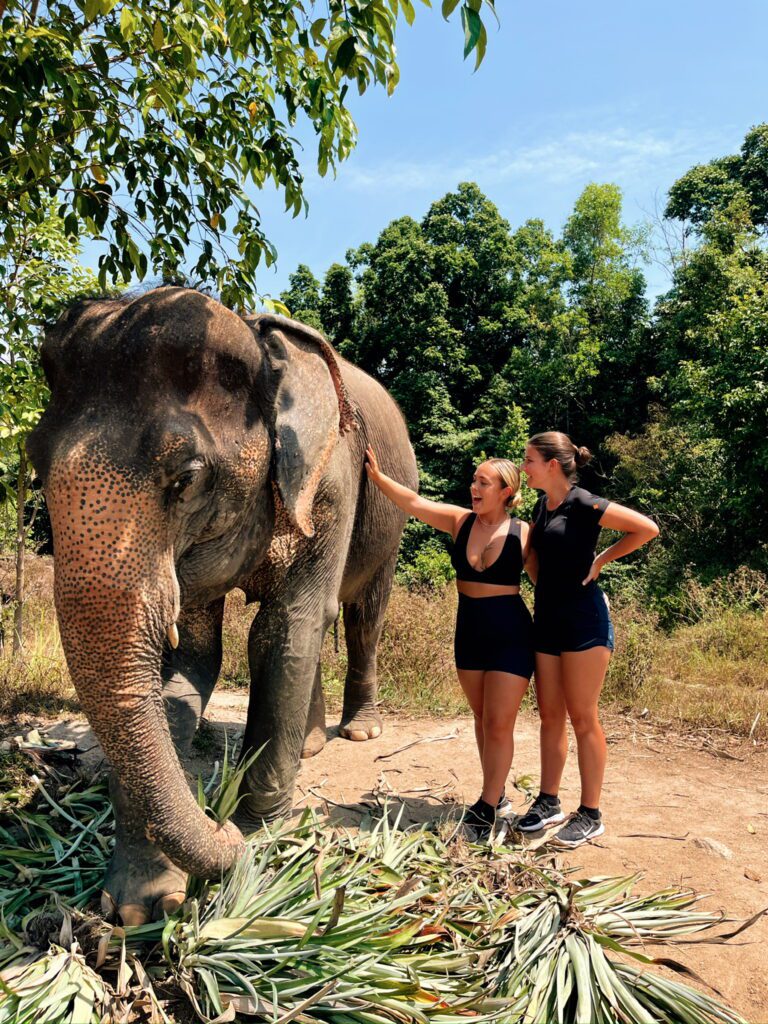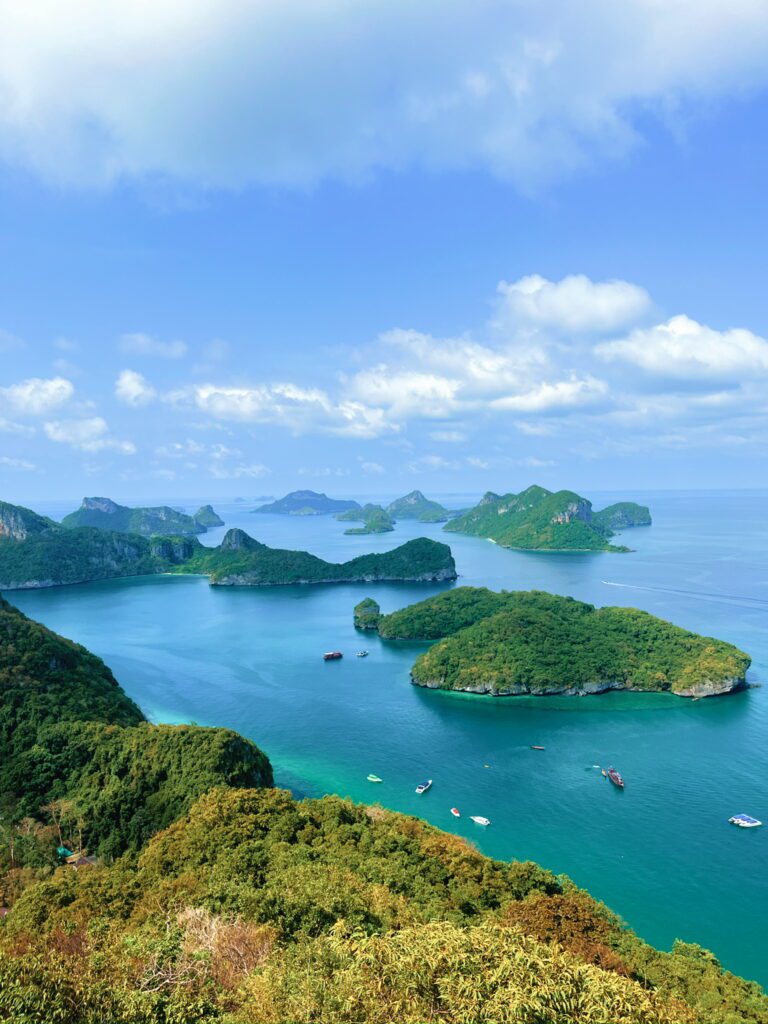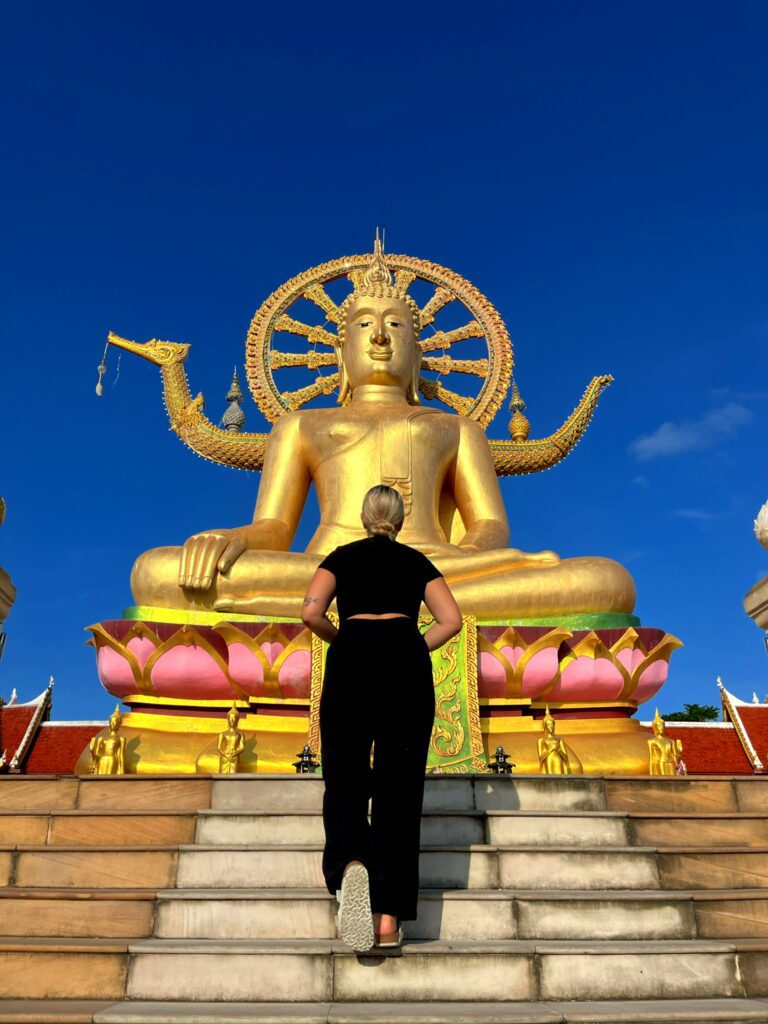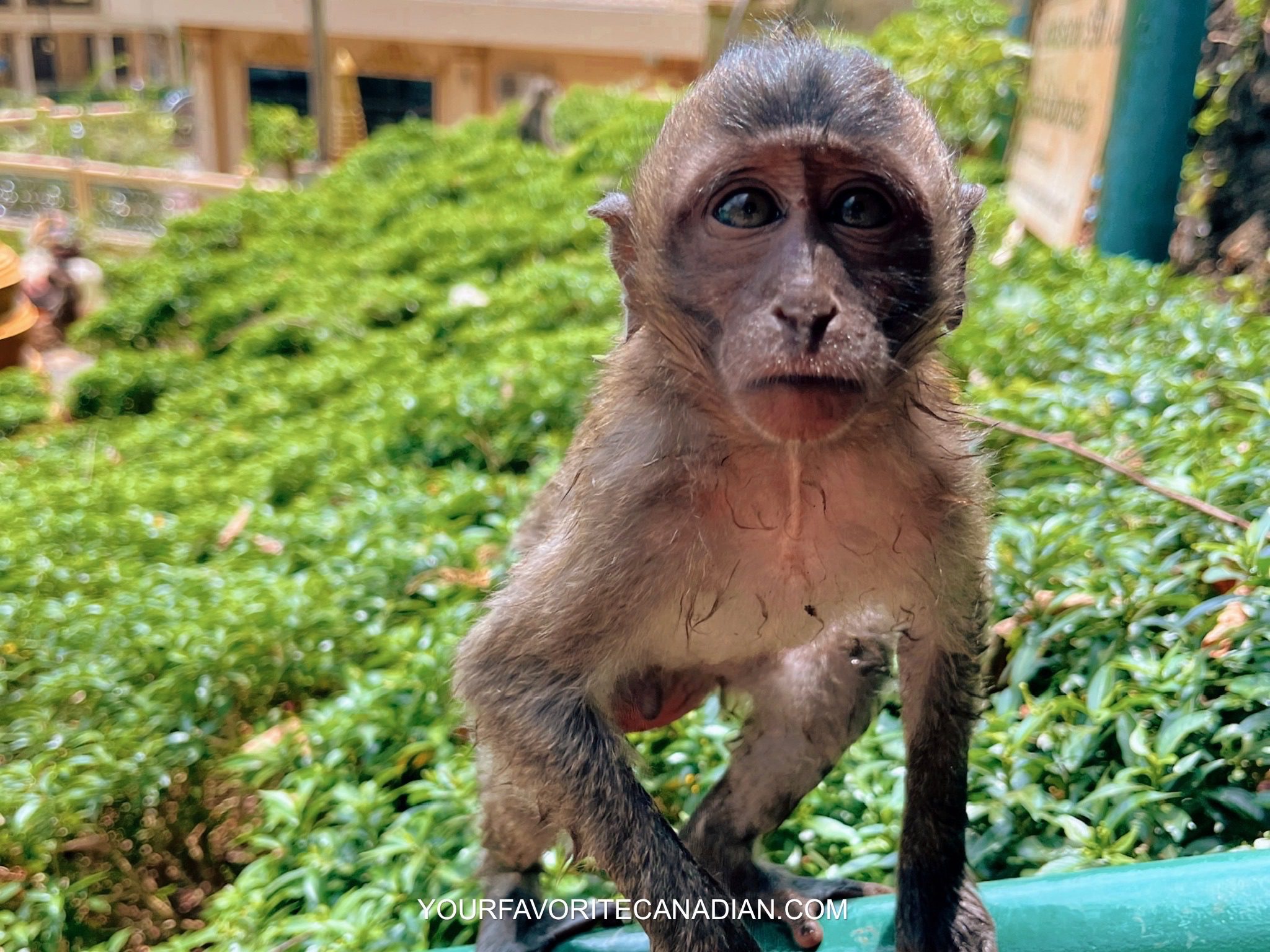Thailand, the Land of Smiles, is a captivating country where rich culture meets stunning landscapes. From the vibrant energy of its cities to the tranquil beauty of its islands, Thailand offers a diverse experience for every traveler. Whether you’re drawn by its ancient temples, renowned street food, or pristine beaches, this Southeast Asian gem promises adventure, relaxation, and unforgettable moments. Let this guide help you uncover the wonders and hidden gems that make Thailand a truly remarkable destination.
- Best Time to Visit: Climate, Crowds & Prices
- Local Culture & Etiquette: Cultural Norms, Langue, Etiquette – Visiting temples
- Money Currency & Payments
- Accommodation Options: Types of Accommodations, Recommendations, Essential Apps
- Local Cuisine
- Transportation: Traveling Between Cities & Islands, Renting a Scooter, Essential Apps
- Safety & Health: Tap Water Conditions, Health Precautions, Emergency Informations, Safety Tips
- Visa Requirements
- Staying Connected: Getting a SIM Card in Thailand
- Top Attractions & Activities
1
Best Time to Visit
Climate
Thailand’s vast size means that the climate varies significantly between the northern and southern regions. Due to their differences, it’s important to consider the specific region you’re visiting when planning your trip.
Northern Thailand experiences three distinct seasons:
Hot Season (March to May): This period brings dry weather and intense heat, with temperatures often soaring to 97°F (36°C). It’s ideal for those who enjoy warmth, but be prepared for the midday sun to feel scorching, especially in the lowlands.
Rainy Season (June to October): Monsoons bring daily showers, with September typically seeing the heaviest rainfall. While the temperatures cool down slightly, the humidity remains high. Northern Thailand’s lush landscapes, however, come alive during this time, offering a more serene and green environment for those who don’t mind the rain. This is also the best time to explore waterfalls at their fullest.
Cool Season (November to February): Though “cool” is relative, especially to those from colder climates like us Canadians, the cooler months offer more comfortable temperatures, ranging from 77°F (25°C) in the day to as low as 41°F (5°C) in the hills. It’s perfect for trekking, exploring temples, or venturing into northern cities like Chiang Mai or Pai without the intense heat or rain.
Southern Thailand, with its tropical climate, maintains fairly consistent temperatures year-round, but it does experience distinct wet and dry seasons, varying by coast:
Eastern Coast (Koh Samui, Koh Phangan, etc.):
- Dry Season: January to August
- Rainy Season: September to December
- Expect brief yet intense downpours in the afternoons during the rainy season.
Western Coast (Phuket, Krabi, Koh Phi Phi, etc.):
- Dry Season: November to April
- Rainy Season: May to October
The wet season can bring strong waves and rainstorms, but it often only rains for short periods, leaving plenty of time for sunshine. However, the seas may be rougher, affecting water-based activities.
Crowds & Prices
High Season (November to March):
This is the most popular time to visit Thailand, particularly from mid-December to the end of January. With cooler, more comfortable temperatures, especially in the north, this period is perfect for outdoor activities like sightseeing and trekking. However, it coincides with international holidays such as Christmas and New Year, bringing larger crowds, especially in popular destinations like Bangkok, Phuket, and Chiang Mai. As demand increases, so do the prices for accommodations, flights, and tours. If you’re visiting during this time, it’s wise to book well in advance and be prepared for higher costs.
Shoulder Season (April to June, September to October):
These months are a great balance between decent weather and fewer tourists. In the south, April can still offer great beach weather, while May marks the beginning of the rainy season in many areas. September and October, although rainier, see fewer visitors, and prices for hotels and activities start to drop. It’s a good option if you want to avoid the crowds but don’t mind a bit of rain.
Low Season (June to October):
While the rainy season can deter some travelers, those who visit Thailand during these months will find lower prices, quieter attractions, and a more relaxed atmosphere. Although rain showers are frequent, they often clear up quickly, leaving time for exploration. Popular tourist spots like Phuket and Krabi are significantly less crowded, and you’ll find better deals on accommodations and tours. This season also offers a more authentic experience, as locals go about their daily lives without the throngs of tourists.
2
Local Culture & Etiquette
Thailand is a country rich in traditions and cultural norms that are rooted in deep respect for others, spirituality, and harmony. As a visitor, it’s important to understand and respect these customs to ensure a positive and respectful experience.
Cultural Norms
Thailand is known as the “Land of Smiles,” and locals take pride in their politeness, humility, and respect for others. It’s important to be aware of a few key cultural norms while traveling in the country:
The Wai: The traditional Thai greeting, known as the wai, involves placing your palms together in a prayer-like gesture and slightly bowing your head. This is a sign of respect, and you’ll encounter it frequently in Thailand. It’s customary to return a wai when offered, except to children or service staff, who may wai to you out of courtesy.
Respect for the Monarchy: Thai people hold their royal family in the highest regard, and any form of disrespect toward the monarchy is taken very seriously. Speaking negatively about the King or the royal family can result in harsh penalties, including imprisonment. It’s important to remain neutral or respectful when discussing the monarchy.
Head and Feet: The head is considered the most sacred part of the body, and the feet are considered the lowest and dirtiest. Avoid touching someone’s head, even playfully, and never point your feet at people, Buddha images, or sacred objects. When sitting in temples, tuck your feet underneath you, away from statues or monks.
Language
The official language of Thailand is Thai, and while English is widely spoken in tourist areas, learning a few basic Thai phrases can go a long way in showing respect and enriching your experience:
- Hello: Sawasdee (สวัสดี) — Add *ka* (ค่ะ) if you’re female, or *krub* (ครับ) if you’re male.
- Thank you: Khop khun (ขอบคุณ) — Again, add *ka* or *krub* based on your gender.
- Yes: Chai (ใช่)
- No: Mai chai (ไม่ใช่)
Etiquette – Visiting Temples
You will likely visit temples during your trip to Thailand, and it’s crucial to respect the sacredness of these places, regardless of your personal beliefs. Ensure your shoulders are covered, and opt for long pants or skirts. Some temples may offer sarongs at the entrance if you’re not dressed appropriately. Always remove your shoes before entering the temple building.
Inside the temple, maintain a quiet and respectful demeanor. Avoid pointing at or touching sacred statues, and never pose for photos with your back turned to a Buddha image. If you wish to take photos, be sure to check if photography is allowed first.
Monks are highly respected in Thai culture. Women should never touch a monk or hand something directly to them, as this is considered inappropriate. If you need to give something to a monk, place it on a nearby surface for him to pick up.
3
Money Currency & Payments
When traveling to Thailand, understanding the local currency and payment methods is essential for a smooth and hassle-free experience. Here’s everything you need to know about managing money during your stay in the country.
Thai Baht (THB): The Local Currency
The Thai Baht comes in both coins and banknotes, with denominations ranging from 1 baht coins to 1,000 baht notes.
Exchange Rates
Exchange rates can fluctuate, so it’s a good idea to check the current rate before you travel. Here’s an approximate range based on typical rates:
- 1 USD usually exchanges for about 30 to 35 THB
- 1 CAD typically exchanges for about 22 to 27 THB
Currency Exchange
When exchanging currency, always use official exchange counters or banks. What I highly suggest you do, is either exchange the money before your trip at your local bank, or, get money out of an ATM that has your card logo on it, and refuse the currency rate. That means your local bank will take care of modifying the currency and high chances are you will get a better rate.
ATM Withdrawal Limits
Be aware that there are withdrawal limits per transaction, often around 20,000 to 30,000 THB (approximately $800-1200 CAD). You may be able to make multiple withdrawals if you need more cash, but each withdrawal may incur a fee.
ATM Fees
Your home bank may charge a fee for international withdrawals, and the local bank operating the ATM may also charge a fee. It’s a good idea to withdraw large amounts at once to minimize fees. You can also ask your bank before your trip how they work on that matter. For me, I only had to pay the local bank fee (around 150 to 220 THB in Thailand) since my bank never charged me and I had no limits.
Security
Use ATMs located inside banks, shopping centers, or other secure locations. Be cautious of any unusual devices attached to the ATM, and cover your PIN when entering it.
Card Payments, Minimum Spend & Transaction Fees
Visa and Mastercard are the most widely accepted cards. American Express and other cards may not be as commonly accepted, especially in smaller establishments. Some places may have a minimum spend requirement for card payments, so it’s useful to ask before making a purchase. Again, check with your bank regarding any foreign transaction fees that may apply when using your card abroad. These can add up, so it’s important to be aware.
Tipping Etiquette
Tipping is not a major part of Thai culture, but it is appreciated in certain situations. In more upscale restaurants, a 10% service charge is often included in the bill. If it isn’t, rounding up or leaving a small tip is a nice gesture. For smaller services like taxis, local restaurants, or street food vendors, tipping is generally not expected. However, if you receive exceptional service, leaving a tip of 10–20 baht is appreciated.
4
Accommodation Options
Choosing your accommodation can significantly impact your travel experience. To help you make the best decision, here’s a breakdown of the three main types of accommodations, with recommendations from our past trips and essential apps that will make booking these stays easier for you!
Types of Accommodations
- Villas: Renting a villa is by far the most visually stunning option, offering unique and original stays that can be truly memorable. Villas are usually equipped like apartments, complete with a kitchen and fridge, allowing you to prepare your own meals. While villas tend to be pricier, you can save money by cooking rather than dining out every day. This option is especially ideal for families or large groups, as splitting the cost can make it more affordable and enjoyable than staying in separate hotel rooms.
- Hotels: Hotels are a classic choice with a wide range of options to suit different budgets. Staying in a hotel offers you the comfort of daily housekeeping, room service, and access to various amenities that you won’t find in a villa, such as spas, yoga classes, and more. If you value security and convenience, hotels are a great option, especially for those who prefer having staff available around the clock to assist with any needs.
- Hostels: For backpackers and budget travelers, hostels are the most economical choice. While they may lack the luxury and comfort of villas or hotels, hostels offer a unique and social experience, perfect for young travelers. You’ll typically have a bed in a shared dormitory, making it an excellent way to meet new people, especially if you’re traveling solo. Many hostels also organize group activities to help guests connect. If you’re young and willing to trade a bit of comfort for a memorable and social experience, hostels are the way to go.
Recommendations
Here are two of my favorite hostels I stayed at during my trip to Thailand:
- iSanook Hostel, Bangkok: Even though it only has a 6-star rating on Hostelworld, this female-only hostel provided the reassurance I needed when arriving solo in Bangkok. Its standout features are safety and cleanliness, making it a reliable choice for women travelers. While it lacks any real ambiance or social scene, if you’re a woman seeking a quiet, secure place to rest for a night or two before diving into the excitement of Thailand, this hostel could be the perfect first stop upon arrival.
- KoKo Party Hostel, Krabi: If you’re looking for a lively party hostel where you can meet lots of new people, participate in pub crawls, and even enjoy free BBQs, this is the place for you. With an 8.8-star rating on Hostelworld, this hostel also offers modern rooms with privacy curtains for each dorm bed, clean bathrooms, and is located just a few minutes’ walk from Ao Nang Beach. However, if you’re seeking a peaceful stay, this might not be the best option. But if you’re ready to have a great time, especially during the pub crawls, you’ll have a blast like we did!
Essential Apps
- Booking.com: This app offers a wide range of accommodations, including hotels, hostels, and villas, all in one place.
- Airbnb: Perfect for finding unique and original villas or apartments that offer a home-like experience.
- Hostelworld: Specializing in hostels, this app features an excellent rating system to help you choose the best option. It also includes group chats where you can connect with others who will be staying at the same hostel.
Extra Recommendation: Once you’ve found a place you like, especially with hotels and hostels, be sure to visit their official website. Often, you can find exclusive discounts when booking directly through them.
Stay connected! Follow us on social media for exclusive content & updates on our travels.



On our website, you’ll find all the essential information and tips, while on our social media, you’ll get even more – including personal experiences, funny moments, stunning videos, and much more!
5
Local Cuisine
Thai cuisine is famous for its bold flavors and balance of sweet, sour, salty, and spicy. Street food is a must-try, with dishes like pad thai (stir-fried noodles), som tum (spicy green papaya salad), mango sticky rice, and satay (grilled meat skewers).
Each region in Thailand has its own specialties:
- Northern Thailand: Known for dishes like khao soi (coconut curry noodles) and sai ua (herb sausage).
- Southern Thailand: Features spicy, seafood-rich dishes like tom yum goong (hot and sour shrimp soup).
- Isaan (Northeast): Famous for larb (minced meat salad) and gai yang (grilled chicken).
Thai meals are often shared family-style, and vegetarians can easily find or adapt dishes. Be mindful of spice levels, and specify “mai phet” if you prefer less heat.
6
Transportation
Getting around Thailand is relatively easy, with a variety of transportation options available for both short and long distances.
Traveling Between Cities & Islands
- Domestic Flights
For long distances, particularly between cities like Bangkok, Chiang Mai, and Phuket, domestic flights are the quickest option. Thailand has a number of budget airlines, including AirAsia, Nok Air, and Thai Lion Air, offering affordable fares. Flights are frequent and cover most major destinations within the country.
- Trains
Thailand’s train network is extensive, connecting many cities and regions. The trains are generally comfortable and affordable, with different classes available ranging from sleeper trains to budget seats. The overnight train from Bangkok to Chiang Mai is especially popular, offering a scenic and relaxing way to travel. It’s recommended to book train tickets in advance, especially during high season.
- Buses and Minivans
Buses are a common mode of transportation, especially for budget travelers. Thailand has a well-organized bus system, with both government and private bus companies operating throughout the country. VIP and first-class buses offer more comfort for long journeys, while local buses provide a cheaper, more basic option. Minivans are also a common way to travel between towns or for shorter distances, though they can be cramped.
- Taxis and Tuk-Tuks
In cities like Bangkok, taxis are widely available and are a convenient way to get around. Be sure to ask the driver to use the meter, as some may try to negotiate a fixed fare. Tuk-tuks, the iconic three-wheeled vehicles, are a fun but less comfortable alternative. Always agree on a price before starting your ride in a tuk-tuk, as meters are not used.
- Ferries and Boats
Thailand’s islands are connected by a network of ferries and speedboats, making travel between islands like Koh Samui, Koh Phi Phi, and Koh Lanta easy and accessible. Ferries tend to be more affordable, while speedboats offer faster, albeit bumpier, rides. During high season, it’s best to book tickets ahead of time, as ferries can fill up quickly.
- Ride-Hailing Apps
Apps like Grab (similar to Uber) are widely used in Thailand, particularly in larger cities like Bangkok, Chiang Mai, and Phuket. They offer car rides, motorcycle taxis, and even food delivery, making it a convenient option for getting around without needing to negotiate prices or worry about finding transportation.
Renting a Scooter: The Best Way to Explore Cities and Islands
Renting a scooter is by far the most popular and efficient way to explore the cities and islands in most of Asia. Scooters are significantly cheaper than cars, can weave through traffic effortlessly, and save you a lot of time. While you can hop on a scooter as a passenger with a driver, renting one yourself is often the best option, especially if you’re planning a full day of adventure. This gives you the freedom to go wherever you want, whenever you want, without having to wait for a driver.
- Cost and Availability: Availability can vary depending on the area. It’s best to rent your motorbike early in the morning, as they tend to get booked quickly. If none are available, ask when the next one will be returned by another traveler. It’s common for rental shops to ask for your passport or an ID as collateral. While this might feel unsettling, I’ve never had an issue personally. For added peace of mind, try offering a copy instead and consider renting from more reputable shops that are closely regulated, though they may charge slightly higher prices than local rentals.
On average, you can expect to pay:
- Basic scooter (100cc–125cc): 150–300 THB per day (approximately 6–12 USD or 8–15 CAD).
- Larger or more powerful bikes (150cc and up): 400–600 THB per day (approximately 12–18 USD or 15–23 CAD).
- Safety Considerations: Always wear a helmet, even though it might not be enforced everywhere. Thailand’s traffic can be chaotic, particularly in busier areas, so it’s essential to be cautious. If you’re not experienced with riding scooters, consider practicing in a quieter area before venturing into busier streets.
- Tips for Choosing Your Scooter: If you’re small in stature, ask for a Scoopy model, which is more compact and easier to handle. You don’t need a large scooter—something small and manageable will do just fine. Also, make sure the scooter has storage space under the seat for your belongings.
- International Driver’s License: While enforcement is inconsistent, it’s advisable to have an international driver’s license. Though I didn’t encounter issues during my month in Thailand and didn’t see anyone getting stopped, it’s better to be prepared just in case.
Essential Apps
Here’s a list of essential transportation apps to help you navigate Thailand efficiently :
- Grab: Grab is the most popular ride-hailing app in Thailand, similar to Uber. It offers various services, including car rides, motorcycle taxis, and food delivery.
- Bolt: Bolt is another ride-hailing app that operates in cities like Bangkok and Pattaya. It often offers cheaper fares than Grab, making it a great alternative.
- Skyscanner: While Skyscanner is commonly used for booking international flights, it’s also a great app for finding domestic flights within Thailand.
- 12Go Asia: 12Go Asia is an essential app for booking various forms of transportation, including buses, trains, ferries, and flights across Thailand and other Southeast Asian countries.
- Google Maps: Google Maps is indispensable for navigating. For major cities like Bangkok, it also provides real-time updates on bus and train schedules. The app allows you to download offline maps which is great if you don’t plan on buying a sim card.
- Thai Railway (SRT) App: This official app by the State Railway of Thailand allows you to check train schedules and book tickets directly. It’s especially useful for booking long-distance trains, such as the popular Bangkok to Chiang Mai route, and for checking availability on sleeper trains.
7
Safety & Health
When traveling to Thailand, it’s important to be aware of both safety and health precautions to ensure a smooth and enjoyable trip. Below are three things to consider: the tap water conditions, other health precautions and emergency information.
Tap Water Conditions
Tap water in Thailand is generally not safe for drinking. While it’s treated in urban areas, contamination can occur during its transport through old pipes.
To stay healthy, always follow these guidelines:
- Opt for bottled water: It’s widely available and affordable. Many hotels and restaurants also provide filtered water for guests.
- Be cautious with ice: It may not always be made from safe water, so be selective about where you consume it.
- Use bottled water for brushing your teeth: This helps avoid accidental ingestion of tap water.
- Rinse fruits and vegetables with bottled or boiled water: This ensures they are free from contaminants.
Health Precautions to Take in Thailand
Thailand is generally safe from major health concerns, but it’s still wise to take some basic precautions:
- Vaccinations: Make sure you are up-to-date with routine vaccines such as measles, mumps, rubella, and tetanus. Additionally, consider getting vaccinated for Hepatitis A, Hepatitis B, and Typhoid, as these are common in Southeast Asia.
- Mosquito Protection: Mosquito-borne diseases like dengue fever and, in certain areas, malaria can be a concern. Use insect repellent with DEET, wear long-sleeved clothing, and sleep under a mosquito net if staying in rural areas.
- Food Safety: Thai street food is a must-try, but make sure to eat from busy stalls where the food is freshly prepared. Avoid raw seafood and dishes that have been sitting out for a long time to minimize the risk of food poisoning.
- Sun Protection: Thailand’s tropical sun can be intense, so apply sunscreen frequently, especially when spending time on beaches or outdoor activities.
Emergency Information
Being prepared for emergencies is an essential part of travel safety. Here’s what you need to know about emergency services in Thailand:
Emergency Numbers
- Police: 191
- Ambulance: 1669
- Fire Department: 199
- Tourist Police: 1155 (English-speaking officers available)
Hospitals and Clinics: Thailand is known for its excellent healthcare services, especially in major cities like Bangkok, Chiang Mai, and Phuket. Private hospitals such as Bangkok Hospital and Bumrungrad International Hospital are often preferred by travelers due to their high standards of care and English-speaking staff. In more rural areas, medical facilities may be more basic, but you can still find local clinics for minor health concerns.
Tips:
- For minor issues, local clinics are sufficient and affordable.
- In serious cases, opt for private hospitals, which offer higher standards of care and faster service.
- Ensure your travel insurance covers medical evacuation, particularly if you plan to visit remote areas where medical facilities may be limited.
Pharmacies: Pharmacies are easily found throughout Thailand, and most common medications are available without a prescription. Be aware that not all medications available in Thailand may meet the same regulatory standards as in your home country, so it’s best to stick to well-known brands. Larger chain pharmacies like Boots and Watsons tend to have staff that speak better English.
Language and Communication: While many medical professionals in Thailand speak English, it’s helpful to have your medical details translated into Thai, particularly if you have specific health conditions or are taking prescription medications.
Safety Tips
Every traveler needs to be cautious, especially if you are solo traveling. We wrote an entire article giving you our best safety tips. Make sure to come back at the end of your reading to read our article Top Safety Tips for Solo Travelers: Stay Safe & Confident.
8
Visa Requirements
Thailand offers various visa options depending on your nationality, purpose of visit, and length of stay. Here’s a general overview of the visa requirements for most travelers looking at the two most popular options:
Visa Exemption (Popular for most Canadians)
Citizens from many countries, including the United States, Canada, the United Kingdom, most European Union nations, Australia, and Japan, are eligible for a visa exemption. This allows them to stay in Thailand for up to 30 days without needing a visa if arriving by air or 15 days if arriving by land.
Key points for visa exemption:
- You must have a passport valid for at least 6 months beyond your stay.
- Proof of onward travel (such as a flight ticket out of Thailand) is often required.
- Extensions of up to 30 additional days can be applied for at a local immigration office for a fee.
Tourist Visa
If you plan to stay longer than the visa exemption period, you can apply for a Tourist Visa. This allows you to stay for 60 days and can be extended once for an additional 30 days at an immigration office.
There are two types of tourist visas:
- Single-entry visa: Allows a single entry into Thailand and permits a stay of up to 60 days.
- Multiple-entry visa: Allows multiple entries into Thailand over a period of 6 months, with each stay capped at 60 days per entry.
Extension of Stay
If you wish to extend your stay beyond the visa exemption or tourist visa period, you can apply for an extension at a Thai Immigration Office. A 30-day extension is usually granted for a fee of approximately 1,900 THB, around 80 CAD.
Overstaying in Thailand
Overstaying your visa can lead to fines and other penalties:
- A fine of 500 THB per day is imposed for each day you overstay, up to a maximum of 20,000 THB.
- Overstaying for more than 90 days can result in a ban from re-entering Thailand for a specified period.
Visa Application Process
Visas can be applied for at Thai embassies or consulates in your home country or nearby countries. Some countries also allow eVisa applications, making the process faster and more convenient.
9
Staying Connected
One of the most affordable and convenient ways to stay connected during your time in Thailand is by purchasing a local SIM card rather than relying on a phone package from your home country. Thailand SIM cards are widely available, inexpensive, and provide excellent coverage across the country.
Where to Buy a SIM Card
While you can buy a SIM card directly at the airport upon arrival, it’s worth noting that prices tend to be significantly higher there. A better option is to purchase a SIM card outside the airport. You can find them in almost every convenience store.
Choosing the Right SIM Card
The cost of your SIM card will depend on how much data you need and where you purchase it. Most vendors offer a variety of packages, so consider how much data you’ll need for your stay. If you plan on using your phone mainly for navigation and occasional social media, a smaller package should suffice. For those who plan to work remotely or stream content, a larger data package will be necessary.
I purchased my SIM card from the company “True Move,” which offered excellent 5G coverage. It cost only 49 BHT, and this price included one day of internet access. The cashier informed me that I would need to return the next day to purchase a data package. However, in a funny twist, I never went back because my SIM card kept working without any interruptions. I ended up enjoying unlimited internet for an entire month in Thailand, all for less than 2 Canadian dollars!
Installation and Tips
When you purchase a SIM card, the vendor should install it for you and ensure it’s working properly. Remember to keep your original SIM card from home in a safe place, so you can easily switch back once you leave Thailand.
If you’re unsure about which provider to choose, ask the vendor about the best network coverage in the areas you plan to visit
10
Top Attractions & Activities
Whether you’re an adventure seeker, a culture lover, or someone in search of relaxation, Thailand has something for everyone.



Now that you know everything about Thailand, it’s time to plan your trip! Here are some articles that could be helpful :






Don’t want to miss out on our latest articles? Be sure to subscribe to our website, and you’ll receive a notification every time we publish something new!
